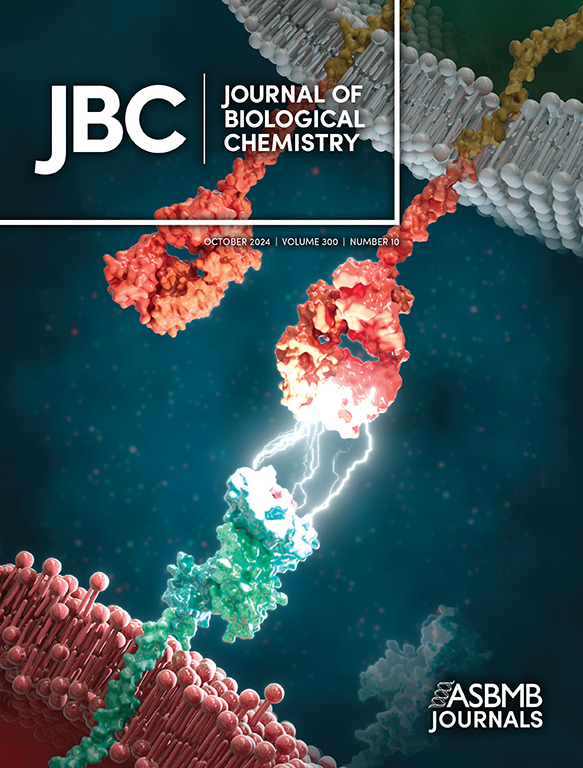核磁共振引导鉴定cyp11a1 -肾上腺素还毒素相互作用差异控制胆固醇和维生素D3代谢
IF 4
2区 生物学
Q2 BIOCHEMISTRY & MOLECULAR BIOLOGY
引用次数: 0
摘要
细胞色素P450 (CYPs)是一种含血红素的酶,对一系列生化过程至关重要,包括类固醇生成和维生素D代谢。在线粒体CYPs中,CYP11A1催化胆固醇侧链裂解产生孕烯醇酮,并催化维生素D3羟基化产生20(OH)D3。先前的研究表明,底物可以调节CYP11A1蛋白与氧化还原伴侣肾上腺素还蛋白(Adx)的相互作用,但底物特异性调节Adx的结构基础尚不清楚。在这项研究中,我们研究了CYP11A1和Adx之间是否存在受胆固醇和维生素D3不同影响的接触,以及这些底物特异性接触是否对CYP11A1单氧合维生素D3或胆固醇侧链切割很重要。利用二维核磁共振波谱结合底物与羟丙基-β-环糊精的增溶作用,我们能够分离出Adx α螺旋-3的M77作为底物特异性接触CYP11A1。将Adx M77位点突变为M77L和M77S,并诱变相应的CYP11A1接触点(W418A),揭示了对胆固醇和维生素D3代谢的不同影响。这些数据表明,CYP11A1蛋白与Adx的相互作用是由底物特异性驱动的,并揭示了其他线粒体CYPs中潜在的底物敏感识别。这些发现在CYP11A1与Adx的减少(功能)形式之间的模型相互作用的背景下进一步讨论,其中Adx M77-CYP11A1 W418是驱动约束。此外,本研究描述了一种基于核磁共振的协议,广泛适用于研究其他底物敏感的cypo -氧化还原伴侣相互作用。本文章由计算机程序翻译,如有差异,请以英文原文为准。
NMR-guided Identification of CYP11A1–Adrenodoxin Interactions that Differentially Govern Cholesterol and Vitamin D3 Metabolism
Cytochromes P450 (CYPs) are heme-containing enzymes essential for a range of biochemical processes, including steroidogenesis and vitamin D metabolism. Among mitochondrial CYPs, CYP11A1 catalyzes both cholesterol side-chain cleavage, producing pregnenolone, and hydroxylation of vitamin D3, producing 20(OH)D3. Previous studies have shown that substrates can modulate CYP11A1 protein–protein interactions with the redox partner Adrenodoxin (Adx), but the structural basis of the substrate-specific modulation towards Adx is not known. In this study, we investigated whether there exist contact(s) between CYP11A1 and Adx that are differentially influenced by cholesterol and vitamin D3, and whether these substrate-specific contacts are important for CYP11A1 monooxygenation of vitamin D3 or side chain cleavage of cholesterol. Utilizing 2D NMR spectroscopy in combination with solubilization of substrates with hydroxypropyl-β-cyclodextrin, we were able to isolate M77 of Adx α helix-3 as a substrate-specific contact towards CYP11A1. Site-directed mutagenesis of Adx M77 into M77L and M77S and mutagenesis of the corresponding CYP11A1 contact (W418A) revealed differential effects towards cholesterol and vitamin D3 metabolism. These data suggest that CYP11A1 protein–protein interactions with Adx are uniquely driven by substrate specificity and shed light on potential substrate-sensitive recognition in other mitochondrial CYPs. These findings are further discussed in the context of a modeled interaction between CYP11A1 and the reduced (functional) form of Adx in which Adx M77–CYP11A1 W418 is the driving constraint. Moreover, this study describes an NMR-based protocol that is broadly applicable towards the investigation of other substrate-sensitive CYP–redox partner interactions.
求助全文
通过发布文献求助,成功后即可免费获取论文全文。
去求助
来源期刊

Journal of Biological Chemistry
Biochemistry, Genetics and Molecular Biology-Biochemistry
自引率
4.20%
发文量
1233
期刊介绍:
The Journal of Biological Chemistry welcomes high-quality science that seeks to elucidate the molecular and cellular basis of biological processes. Papers published in JBC can therefore fall under the umbrellas of not only biological chemistry, chemical biology, or biochemistry, but also allied disciplines such as biophysics, systems biology, RNA biology, immunology, microbiology, neurobiology, epigenetics, computational biology, ’omics, and many more. The outcome of our focus on papers that contribute novel and important mechanistic insights, rather than on a particular topic area, is that JBC is truly a melting pot for scientists across disciplines. In addition, JBC welcomes papers that describe methods that will help scientists push their biochemical inquiries forward and resources that will be of use to the research community.
 求助内容:
求助内容: 应助结果提醒方式:
应助结果提醒方式:


